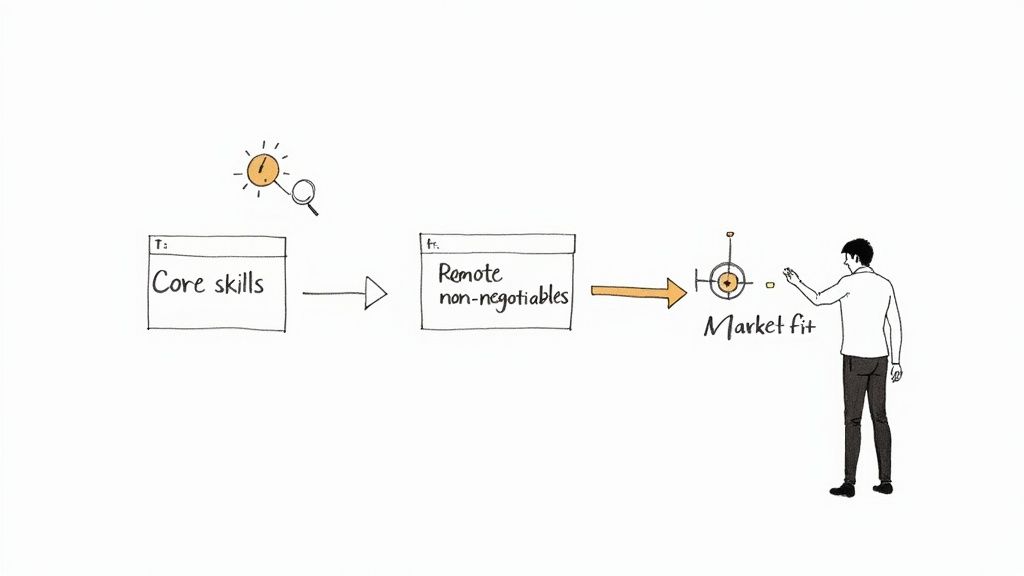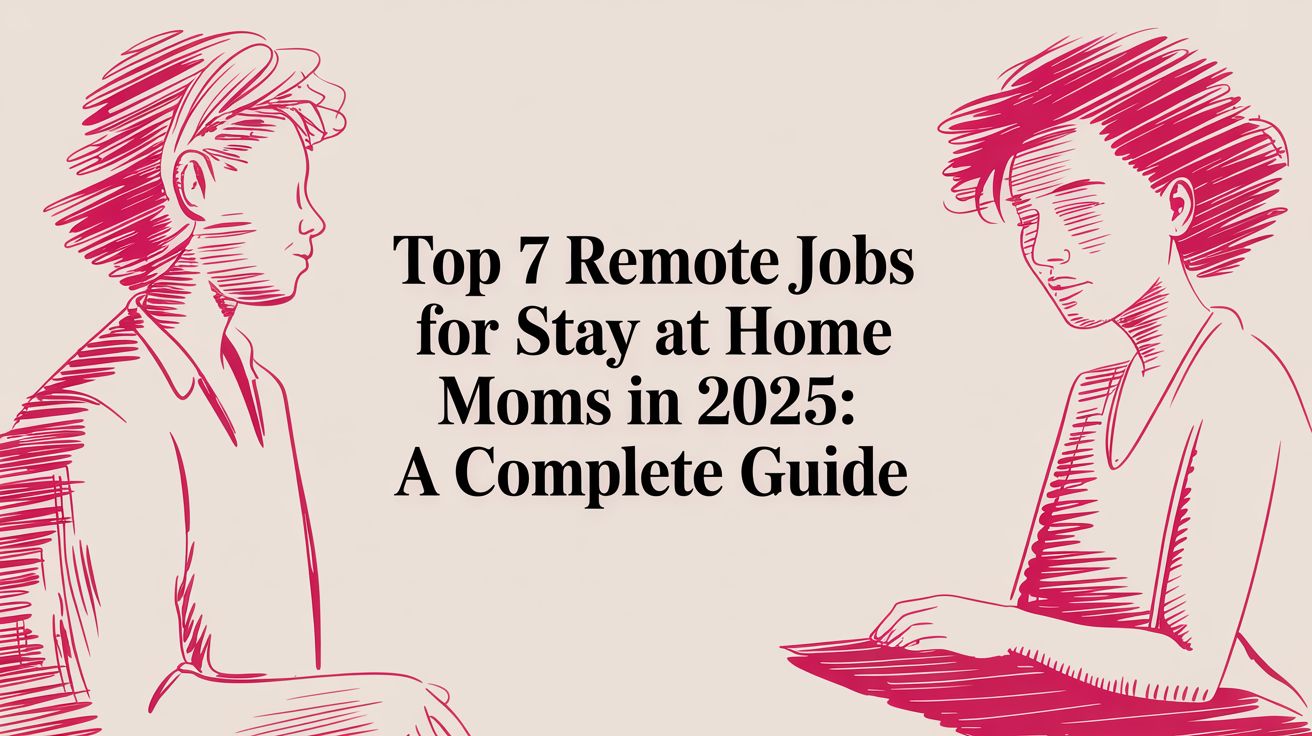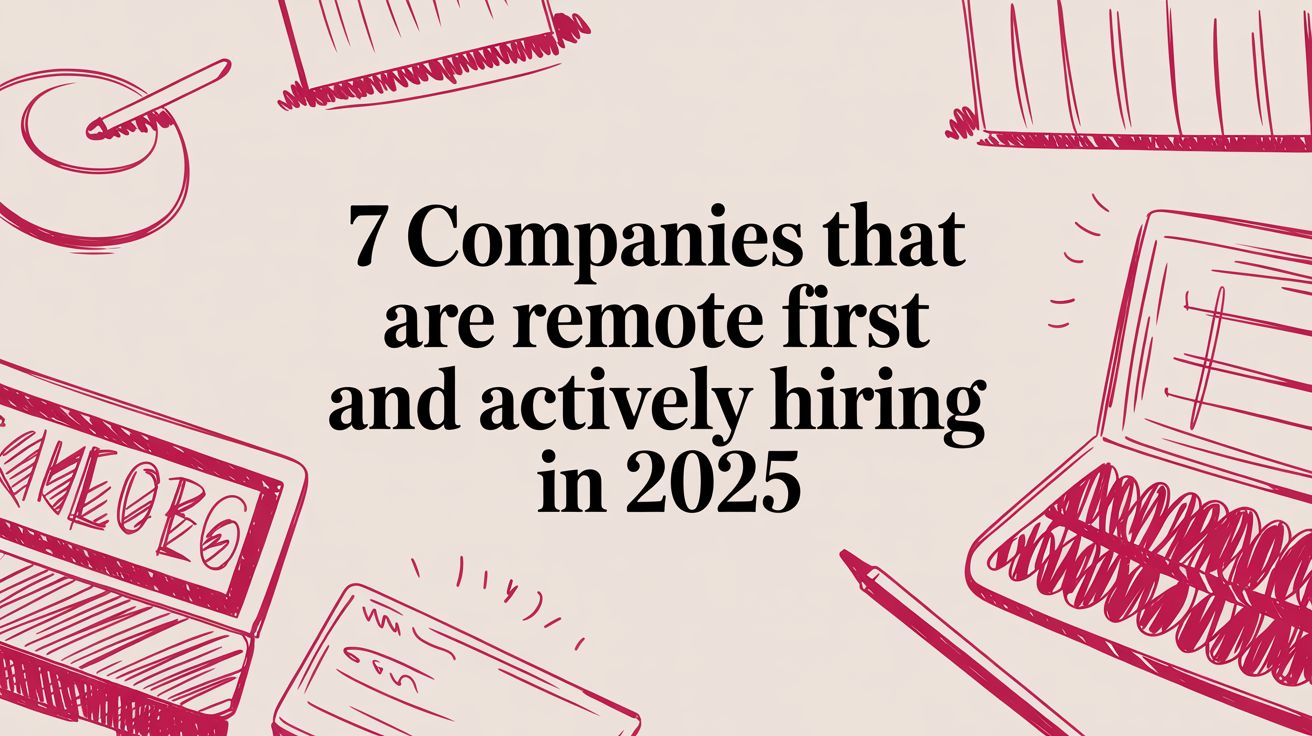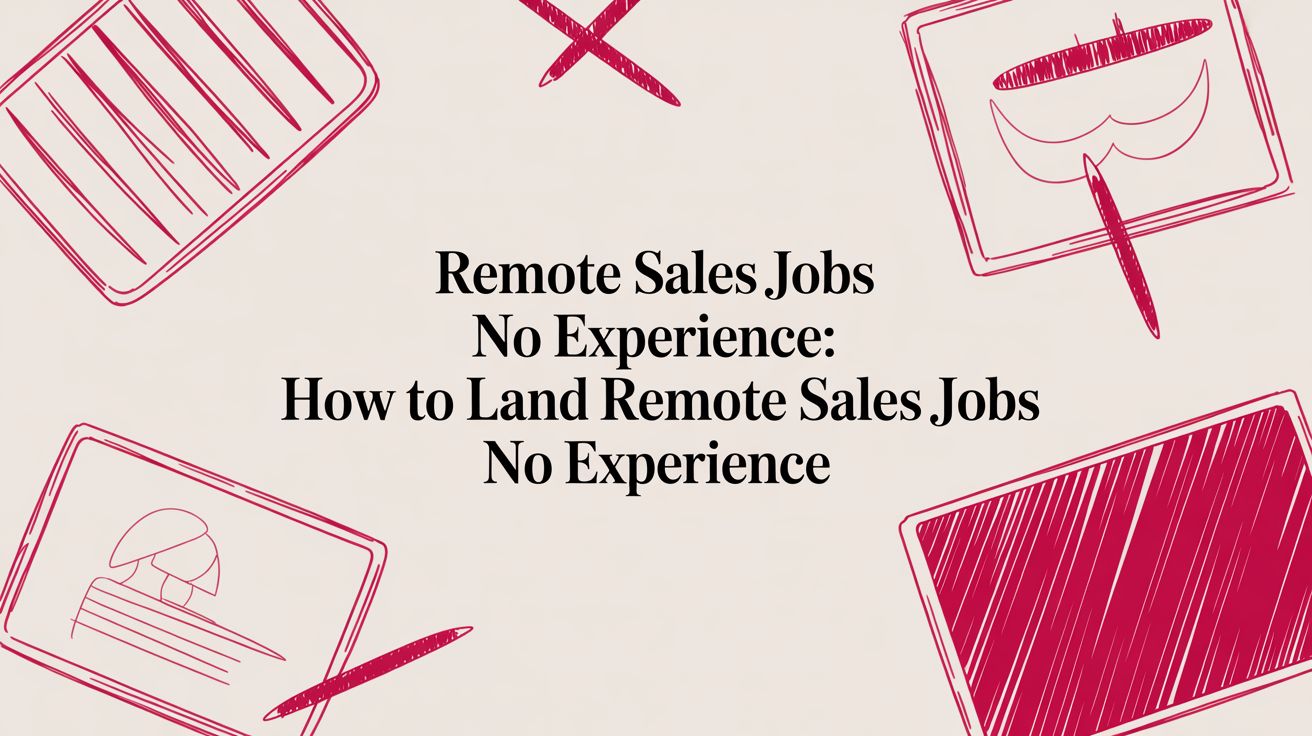A Modern Job Search Plan for Remote Roles
Max
A solid job search plan is your roadmap. It turns a frustrating, reactive hunt into a proactive campaign designed to land the remote role you actually want, faster.
Build a Foundation for Your Remote Job Search

Before you even think about firing off applications, you have to do the foundational work: deep self-reflection and a hard look at the market.
Jumping straight to job boards without this prep is like trying to build a house without a blueprint. It’s chaotic, stressful, and rarely leads to a good outcome. A clear plan gives you direction and, just as importantly, keeps you motivated when the search gets tough.
The job market today is too competitive to just wing it. To put it in perspective, in the U.S. alone, over 257,000 workers were laid off in just the first four months of one recent year. That’s more than the entire previous year combined. This volatility is exactly why having a structured, adaptable plan isn’t just nice—it’s essential.
Define Your Remote Work Non-Negotiables
First things first, you need to get brutally honest with yourself about what you’re looking for. This goes way beyond job titles. It’s about understanding your core skills, your deal-breakers, and the kind of environment where you’ll actually do your best work.
Answering these questions now will save you from wasting weeks chasing roles that are a bad fit from the start.
Ask yourself:
- What am I genuinely good at? List your hard skills (like Python, Figma, or SEO) and your soft skills (like leading a team or managing difficult client conversations).
- What kind of company culture drains me vs. energizes me? Do you love the fast-paced, “figure it out as you go” vibe of a startup, or do you need the structure of a large, established company to thrive?
- What’s my financial reality? Know your absolute minimum salary and how long your savings can carry you. This isn’t the time for wishful thinking.
- What are my absolute must-haves for a remote job? This could be timezone flexibility, an asynchronous-first communication style, or a solid professional development budget.
I see it all the time: people focus only on what they can do instead of where they can thrive. Your job search plan has to cover both—your skills and the environment that lets you use them effectively.
Conduct a Personal SWOT Analysis
To give this self-assessment some structure, a personal SWOT analysis is a fantastic tool. It’s a simple framework for organizing your thoughts and spotting what to work on. SWOT stands for Strengths, Weaknesses, Opportunities, and Threats.
The goal is to map your internal factors (Strengths, Weaknesses) against external market factors (Opportunities, Threats). This gives you a 360-degree view of where you stand right now.
Here’s how it might look for a remote project manager:
- Strengths: “I have five years of experience in project management and I’m a certified Agile expert.”
- Weaknesses: “My network in the tech industry is pretty small, and I’ve never used Asana, which seems to be everywhere.”
- Opportunities: “The demand for remote project managers is booming, and I’ve identified three target companies that are actively hiring.”
- Threats: “The market is flooded with experienced candidates applying for the same roles.”
This isn’t just an exercise; it creates an action plan. Your weakness in networking becomes a new goal: “Attend two virtual industry events this month.” The threat of competition becomes a prompt: “I need to rework my resume to highlight my unique wins on complex projects.”
This foundational work is critical. As you build on this, our guide on the best way to find remote jobs can give you even more strategies to sharpen your approach.
Craft Your Digital First Impression
 In the remote world, your first handshake is digital. Long before you ever speak to a hiring manager, your online presence has already made an introduction. That’s why building a cohesive, professional brand is a non-negotiable part of your job search plan.
In the remote world, your first handshake is digital. Long before you ever speak to a hiring manager, your online presence has already made an introduction. That’s why building a cohesive, professional brand is a non-negotiable part of your job search plan.
This goes way beyond just having a profile. It’s about strategically crafting your digital footprint to catch the eye of remote recruiters. Your LinkedIn profile, resume, and cover letter need to tell one single, powerful story about the value you bring as a remote employee.
Optimize Your LinkedIn Profile for Remote Work
Recruiters live on LinkedIn, and it’s often the first place they’ll look you up. Your profile needs to do more than just list your past jobs—it needs to actively sell your ability to thrive in a remote setting.
Think of your headline as a billboard. Instead of a generic “Project Manager,” try something that screams remote-ready: “Certified Project Manager | Asynchronous Communication Expert | Driving Remote Team Success.” This immediately tells a recruiter you get it.
Next, you’ll want to sprinkle remote-specific keywords throughout your “About” and experience sections. What would a recruiter search for?
- Remote collaboration tools like Slack, Asana, Miro, or Trello
- Key skills such as asynchronous communication, time management, and self-discipline
- Common phrases like “distributed team,” “virtual collaboration,” or “remote-first environment”
These small changes can make a huge difference in how often you show up in searches. For a deeper dive, check out our complete guide on how to optimize your LinkedIn profile. https://remotefirstjobs.com/blog/how-to-optimize-linkedin-profile
Beat the Bots with an ATS-Friendly Resume
Here’s a hard truth: a human probably won’t be the first to read your resume. It’ll be an Applicant Tracking System (ATS). These bots scan for keywords and proper formatting, and if your resume isn’t built for them, it could get tossed before it ever has a chance.
To get past the bots, keep it simple. Avoid weird formatting like tables, columns, or fancy graphics that can confuse the software. Stick to a clean, single-column layout and use standard fonts.
The single most effective strategy is to mirror the language in the job description. If a company is looking for “experience managing cross-functional teams,” make sure that exact phrase is in your resume. This simple customization is your ticket past the digital gatekeepers.
Write Cover Letters That Connect and Compel
A great cover letter is more than just a summary of your resume—it’s your opportunity to tell a story. It’s where you connect the dots for the hiring manager, showing them exactly how your skills solve their specific problems.
Start by zeroing in on the company’s pain points. You can usually find clues right in the job description. For instance, if a posting mentions they are “scaling their remote marketing team,” your cover letter needs to highlight your experience growing distributed teams or managing projects across different time zones.
Remember, you’re not the only one looking. Roughly 30% of the global workforce is actively job hunting, and another 70% are open to new roles if the right one appears. A compelling cover letter is how you cut through the noise.
If you want to ensure your entire digital presence is sharp and aligned, you might consider professional comprehensive resume, cover letter, and LinkedIn profile services. A cohesive package signals to employers that you’re a serious candidate ready to hit the ground running in a remote role.
Move Beyond Online Job Applications
If your entire job search strategy boils down to hitting the “Apply Now” button, you’re setting yourself up for a long, frustrating road. It feels productive, but sending applications into the digital void is a low-yield game. To break through the noise, you need a proactive networking strategy.
This isn’t about schmoozing or awkward self-promotion. It’s about building real connections, offering value first, and gathering intel long before you even think about applying. This is how you tap into the hidden job market—where roles get filled through referrals before they ever see a public job board.
Adopt a Value-First Networking Mindset
Let’s get one thing straight: the golden rule of networking is to give before you ask. People are much more open to helping someone who approaches them with genuine curiosity and respect, not a blunt demand for a job.
Your first move is just to start a conversation, not to ask for a favor. Keep your initial outreach light, personalized, and focused on them.
Here’s how to reframe your thinking:
- Instead of asking for a job, ask for their take on a trend in the industry.
- Instead of attaching your resume, share a cool article or praise their latest project.
- Instead of saying “Can you help me?,” try “Would you be open to sharing a bit about your experience in the field?”
This value-first approach immediately sets you apart. You’re not just another job seeker; you’re a peer who’s engaged and thoughtful. That’s how you open the door to a real conversation.
A successful job search is less about what you know and more about who knows you. Building relationships creates advocates who will think of you when an opportunity arises, giving you an invaluable advantage.
Identify Key People and Craft Your Outreach
So, who should you talk to? Start by targeting people at companies you’re genuinely interested in. Look for individuals in roles one or two levels above the position you want—these are often the team leads or hiring managers with actual influence.
Once you’ve found a few people on LinkedIn, it’s time to craft your outreach message. This is your first impression, so make it count. Keep it short, personal, and easy for them to say “yes” to.
Example Outreach Template
Subject: Quick question about your work at [Company Name]
Hi [Name],
I was really impressed by the recent [mention a specific project, article, or company achievement] at [Company Name]. Your team’s approach to [mention a specific detail] is fascinating.
As a [Your Role] passionate about [Your Field], I’m always looking to learn from leaders in the space. Would you be open to a brief 15-minute chat in the coming weeks to share a bit about your journey?
Thanks, [Your Name]
This message works because it’s not generic. It proves you’ve done your homework, and it makes a clear, low-commitment request. You’re asking for advice, not a job.
The Power of the Informational Interview
An informational interview isn’t a secret job interview; it’s a casual chat where your only goal is to learn. You’re gathering insider knowledge about company culture, team challenges, and what it really takes to succeed there.
Prepare for these conversations like you would for any other professional meeting. Have smart questions ready that go deeper than what you can find on the company’s “About Us” page.
- What does a typical day in your role actually look like?
- What are the biggest challenges your team is trying to solve right now?
- What qualities do the most successful people at [Company Name] all seem to share?
Before you wrap up, always ask this magic question: “Is there anyone else you’d recommend I connect with?” This simple question can turn one great conversation into a chain of valuable connections, dramatically expanding your network.
By building these relationships, you’ll be the person they think of when new opportunities pop up, especially at some of the best remote-first companies hiring right now.
Nail the Remote Interview Process

This is where all your hard work pays off. The interview process is when your job search plan goes from theory to live performance. In a remote world, your screen is the stage, and knowing the unwritten rules of virtual interviews is the only way to make a great impression.
It’s about more than just having the right answers. It’s about showing you can connect, communicate, and get things done from anywhere.
Remote interviews come with their own unique set of curveballs, from surprise tech glitches to the challenge of building real rapport through a screen. To succeed, you need a smart mix of tech readiness and sharp communication skills. The goal is to come across as polished, capable, and completely at ease.
Set Your Virtual Stage for Success
Long before you say a single word, your environment is already talking. A chaotic background, shadowy lighting, or tinny audio can scream unprofessionalism and distract the interviewer from what you’re actually saying.
Think of your interview space the same way you’d think about your outfit—it needs to be clean, organized, and free of interruptions.
So, before the big day, you absolutely have to do a full tech rehearsal. This isn’t just about checking your Wi-Fi. It’s a complete dress rehearsal for your entire setup.
- Test your platform: Whether it’s Zoom, Google Meet, or Microsoft Teams, jump on a quick call with a friend. Get comfortable with the mute button and know exactly how to share your screen without fumbling.
- Check your audio: Please, use headphones with a built-in mic. It’s the easiest way to kill echo and block out that dog barking next door. Your voice should sound crisp and clear.
- Get the lighting right: The trick is to have your main light source in front of you, not behind. Natural light from a window is perfect, but a simple desk lamp can work wonders to light up your face and avoid looking like you’re in a witness protection program.
- Curate your background: A clean, neutral background is your best bet. A tidy bookshelf or a simple wall is infinitely better than a view of your unmade bed. A tasteful virtual background can work in a pinch, but an authentic, professional space usually feels more genuine.
The goal is to make the technology invisible. When everything just works, the focus stays where it should be: on you and why you’re the right person for the job.
Project Confidence Through the Camera
Building a genuine connection through a laptop is an art form. Without the benefit of being in the same room, your body language, eye contact, and even your vocal tone have to do all the heavy lifting to show your enthusiasm and confidence.
Sit up straight and lean in slightly to show you’re engaged. Don’t be afraid to use hand gestures like you normally would.
Here’s one of the most important tips I can give you: look directly at the camera lens when you speak, not at the interviewer’s face on your screen. It feels weird at first, but to them, it looks like you’re making direct eye contact, which builds a much stronger connection. To really get comfortable and show off your skills, check out these additional 5 Tips for a Remote Job Interview.
Answer Remote-Specific Questions with Finesse
You can bet they’ll ask questions designed to see if you have what it takes to work remotely. Hiring managers need to know you’re a self-starter who can crush it without someone looking over your shoulder.
Be ready with specific examples that prove your skills in these key areas.
Expect to hear things like:
- How do you stay motivated and manage your time when working from home?
- Can you describe your experience with asynchronous communication tools?
- How do you build relationships with colleagues you’ve never met in person?
For a deeper dive, our guide has more remote interview tips to help you practice and polish your answers. Having solid stories ready shows you’ve not only thought about these challenges but have already figured out how to solve them.
Track Your Progress and Refine Your Plan

Here’s a hard truth: a job search plan isn’t a “set it and forget it” document. Think of it as a living, breathing strategy that needs to adapt based on what the real world tells you.
If you send out 100 applications and hear crickets, just sending another 100 the same way isn’t smart—it’s just repeating a failed experiment. The secret sauce is tracking your efforts, looking at the data, and making intelligent tweaks.
This approach shifts you from being a passive applicant to an active strategist. It’s about stopping yourself from wasting time and energy on tactics that just aren’t landing. By keeping tabs on your results, you can pinpoint exactly where things are breaking down and fix them.
Choose Your Tracking System
You don’t need some over-the-top project management software for this. Seriously, the best tool is the one you’ll actually use every day.
For a lot of people, a simple spreadsheet is all it takes. Just create columns for the company, the role, the date you applied, which resume version you sent, the current status, and any next steps. Done.
If you’re more of a visual person, tools like Notion or Trello are fantastic. Their Kanban-style boards are incredibly satisfying. You can create a card for each application and physically drag it across columns like “Applied,” “Interviewing,” and “Offer.” It gives you a real sense of momentum.
This isn’t just about keeping records; it’s about finding clues. The goal is to turn all this raw data into insights that make your strategy sharper each week.
Analyze Your Data to Find Patterns
After about a month of tracking, it’s time to put on your detective hat. Start digging through your data to see what’s working and what’s falling flat. This feedback loop is what makes your plan so powerful.
- Low Application Response Rate? If you’ve sent out 50 targeted applications and have heard nothing back, the problem is almost certainly your resume or cover letter. It’s not grabbing attention or it’s getting filtered out by applicant tracking systems (ATS). Time to start A/B testing different resume formats or rewriting your summary.
- Getting First Interviews but No Second Calls? Hey, good news—your resume is doing its job! But if you keep stalling after the first call, the issue is likely your interview performance. You might need to sharpen your answers, practice telling your career story, or do a better job of explaining how your skills will solve their specific problems.
Your job search data tells a story. A high volume of applications with zero interviews is a clear signal that your initial pitch—your resume—needs a complete overhaul. Don’t ignore what the numbers are telling you.
Key Metrics for Your Job Search Tracker
To really get granular, you need to track more than just the basics. The table below outlines the key data points that will give you the most valuable feedback on your job search performance.
| Metric to Track | Why It’s Important | Tool/Method |
|---|---|---|
| Application Source | Reveals which job boards or networking channels are actually generating interviews. | Spreadsheet column or tag in Trello/Notion. |
| Resume/Cover Letter Version | Helps you A/B test different approaches to see which one gets more responses. | Simple versioning (e.g., “Resume_v1_Marketing”). |
| Response Rate | The percentage of applications that get any kind of reply (even a “no”). | (Total Responses / Total Applications) * 100. |
| Interview Rate | The percentage of applications that lead to an interview. Your most critical metric. | (Interviews Secured / Total Applications) * 100. |
| Time-to-Interview | The average number of days from application to first contact. | Calculate the average in your spreadsheet. |
| Interview-to-Offer Ratio | Shows how effective you are once you get in the door. | (Offers Received / Interviews Conducted) * 100. |
By focusing on these specific numbers, you can move from guessing what’s wrong to knowing exactly where to focus your energy for improvement.
This constant refinement is more important now than ever. The labor market is always shifting, with projections suggesting that technology will impact roughly 22% of current jobs through either creation or destruction. An adaptive job search plan, fueled by real data, is your best tool for building long-term career resilience. For more on this, check out these future of work trends.
When you track and iterate, you’re not just finding a job for today; you’re building a skill set for navigating your entire career.
Common Job Search Plan Questions
Even with the sharpest strategy, you’re going to hit some bumps in the road. It’s just part of the process. A solid job search plan isn’t about avoiding those challenges—it’s about knowing how to push through them when they pop up.
Think of this section as your personal troubleshooting guide. These are the questions that come up again and again from job seekers trying to navigate the remote world. The answers here are designed to help you tweak your approach, stay motivated, and keep moving forward.
How Long Should My Job Search Take?
Ah, the million-dollar question. The honest answer? It depends.
You might have heard the old rule of thumb: expect one month of searching for every $10,000 of your target salary. So, a $60,000 role could take about six months to land. But let’s be real—that’s a loose guideline at best, not a hard-and-fast rule.
The real point of a strong job search plan isn’t about hitting some arbitrary deadline. It’s about making your time count. A well-built plan makes sure you’re spending your energy on high-impact stuff, like targeted networking and customizing your applications, not just spamming the “apply” button on hundreds of listings.
By tracking your progress—like your application-to-interview ratio—your plan becomes a powerful diagnostic tool. For example, if you’re getting plenty of first interviews but never a call back for a second, your plan tells you to pause the applications and start working on your interview stories. That kind of efficiency is what actually shortens your search time.
A job search plan doesn’t speed up time, but it does stop you from wasting it. It turns the process from a waiting game into a series of strategic moves, helping you identify and fix bottlenecks instead of getting stuck in them.
What Is the Biggest Mistake People Make?
Hands down, the single biggest mistake is dumping 100% of your time and effort into submitting online applications. It feels productive, sure, but it’s a numbers game with terrible odds that often leads straight to burnout.
While online applications have their place, they should only be one part of a much bigger strategy. A successful job search plan carves out time for several key activities that actually move the needle:
- Networking: Building real, genuine connections with people in your target industry.
- Personalization: Customizing every single resume and cover letter for the specific role you want.
- Interview Prep: Rehearsing your stories and getting ready for remote-specific questions.
- Strategic Follow-up: Keeping your name top-of-mind with recruiters and hiring managers.
Ignoring the networking piece is the most critical error you can make. Many of the best remote jobs are filled through referrals or direct outreach long before they ever hit a public job board. Your plan absolutely must have dedicated time for building relationships—your network is your single most powerful asset. For a closer look at this, our guide on finding legitimate work-from-home jobs digs into how to find these less obvious opportunities.
How Do I Stay Motivated When My Search Stalls?
It’s completely normal to feel your motivation tank during a long job search. The secret to staying resilient is to build motivation and feedback loops directly into your plan. This turns that feeling of frustration into fuel for your next move.
First, you have to redefine what “success” looks like each day. If your only goal is “get a job offer,” you’re setting yourself up for a long string of disappointments. Instead, you need to celebrate the small, controllable wins along the way.
Examples of Small Wins to Celebrate
- Making a new connection: You had a great informational chat with someone at a company you admire.
- Getting positive feedback: A recruiter mentioned they were impressed with your portfolio or a well-written cover letter.
- Nailing an interview answer: You perfectly explained a complex project and its awesome outcome.
Celebrating these smaller victories shifts your focus from what you don’t have to what you are accomplishing, which is crucial for keeping your momentum up.
Second, start using your tracking data as a diagnostic tool, not a report card. If you’ve sent out 100 resumes and gotten zero calls, the data isn’t screaming that you’re a failure. It’s giving you a clear, objective signal: your resume is the problem, and it needs fixing.
This mindset transforms your job search from a simple pass/fail test into a series of experiments. You’re constantly gathering data, forming a hypothesis (“I think my resume summary is too generic”), making a change, and testing the results. This scientific approach keeps you focused on problem-solving and improvement, which is way more empowering than just sitting around waiting for the phone to ring.
Ready to put your plan into action? Remote First Jobs is your dedicated partner in finding the perfect remote role. With over 40,000 vetted opportunities, our platform connects you with companies that are serious about remote work. Start your smarter, more effective job search today at https://remotefirstjobs.com.


